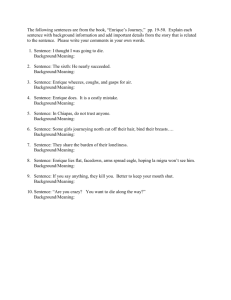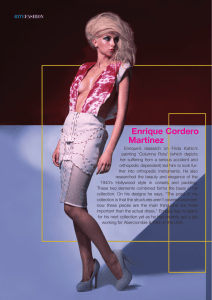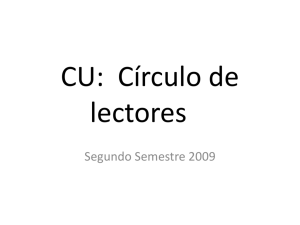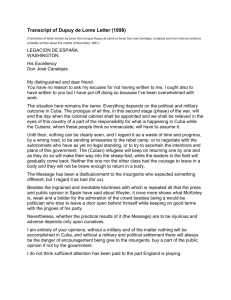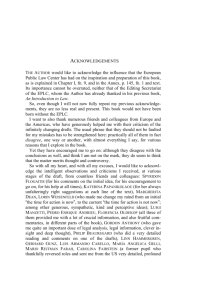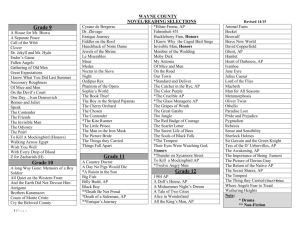NAU Reads
advertisement
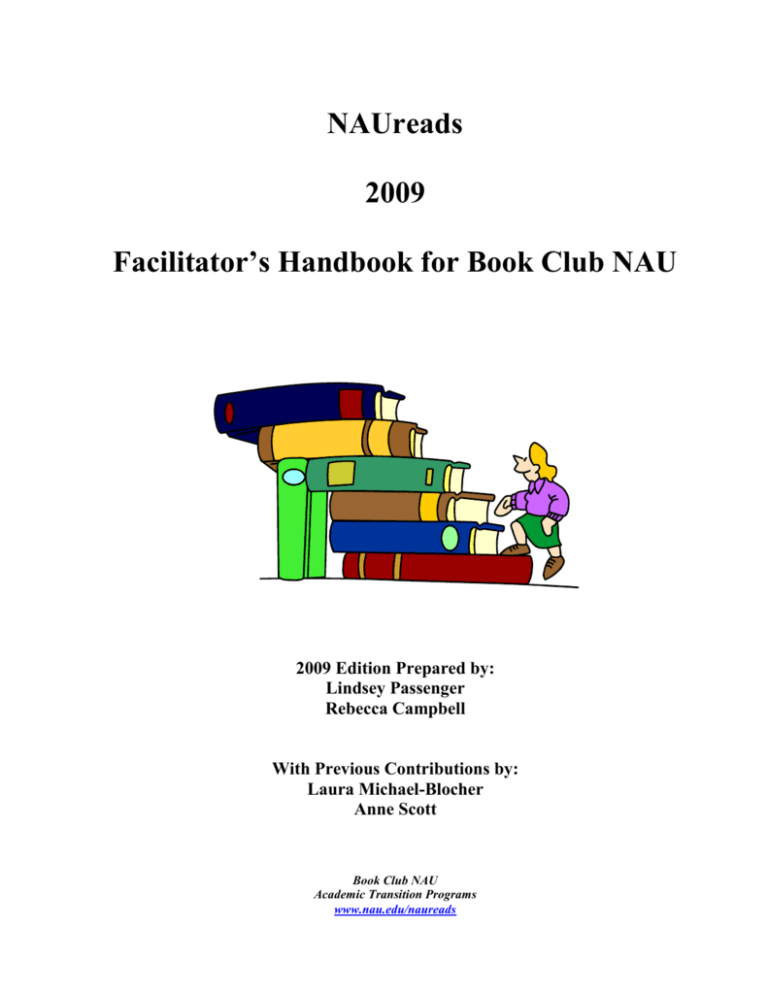
NAUreads 2009 Facilitator’s Handbook for Book Club NAU 2009 Edition Prepared by: Lindsey Passenger Rebecca Campbell With Previous Contributions by: Laura Michael-Blocher Anne Scott Book Club NAU Academic Transition Programs www.nau.edu/naureads Contact: 523-2803 This Year’s Text: Reception and Features Enrique’s Journey, by Sonia Nazario It appeals to both male and female students; It is accessible to a wide audience, from first-year students to graduate students, educators, friends, and family members; It reads quickly because its content is compelling; It is the right length. It addresses many themes. It addresses, in particular, the themes of survival, community, education, family, diversity, racism, violence, drugs, redemption, foreign relations, politics, and immigration issues. It can be read as a narrative and in other ways: as a commentary on contemporary Latin America, border, and immigration issues; as a riveting story; and as a window into the “human condition” from the perspective of a young Honduran man. It touches upon some of the emotions and issues that some of our first-year students might be dealing with, namely, loneliness, connection to family, the temptation to succumb to violence and drugs, etc. It broadens students’ awareness of cultures not their own. It has been on numerous other common reading program reading lists and has been selected for many reading groups nation-wide. It has been received very well thus far by orientation leaders and peer facilitators. About the Book Sparked by a conversation with the author’s maid, Carmen, about Carmen’s separation and reunion with her own son, Minor, Enrique’s Journey began as a series of articles for the Los Angeles Times. After their publication, the articles won two Pulitzer prizes (feature writing for Sonia Nazario and feature photography for Don Bartletti), the George Polk Award for International Reporting, and the Grand Prize of the Robert F. Kennedy Journalism Awards. Realizing that the immigrant’s journey was “the adventure story of the twenty-first century,” Sonia Nazario set out to tell a story that is very common — the story of the trek to the United States (xvi). The unique aspect of her treatment, however, is that the immigrant whose story she chooses to tell is only a child, and he is one, Nazario discovered, of “an estimated 48,000 children who enter the United States from Central America and Mexico each year, illegally and without either of their parents” (5). While she was researching the story, Nazario also discovered the many hazards of these children’s journeys and the sometimes disappointing outcome of their reunions with their families. Enrique’s Journey tells the true story of a five-year-old boy whose mother leaves him behind in Honduras so that she can seek better fortune in America. Planning only to stay until she can send for her children or return with enough money to support them, Enrique’s mother promises to bring him to be with her, but each year setbacks prevent her from keeping her promise. Enrique desperately misses his mother and believes that only she can understand and support him. After disappointing stays with other relatives, Enrique decides he will go to America to find his mother. With only her phone number on a piece of paper, Enrique sets out on the perilous journey at age 16. His journey means hopping trains to get through Mexico to the United States border. Seven times he fails; each time, though, he learns ways to make it further on the next trip. After terrible hardships — attacks by gang members, near misses on the train, extreme hunger and thirst — Enrique makes it to his mother, only to find that in the years of separation, his image of her and the reality he finds are very much different. Summary taken from: Random House Inc, Academic Resources. http://www.randomhouse.com/acmart/catalog/display.pperl?isbn=9780812971781&view=tg Appendix: Activities This handbook contains several discussion activities which you may elect to use. We aimed to provide enough detail that you could “grab them and go” or you could simply use them as impetus for designing your own activities. Activity Master List: Activity Inner Circle/Outer Circle Timeframe ~20 minutes What?/So What?/Now What? ~20 minutes or longer Study Guide to Discussion Questions Social Barometer ~20 minutes or longer Word Tree ~10 minutes or longer ~10 minutes or longer Fishbowl Enrique’s Journey Debate ~20 minutes or longer Quotable Quotes ~20 minutes Force Field Analysis ~20 minutes or longer Frierian Fishbowl ~20 minutes or longer (depends on class size) Notes Whole group participation Can be used with students who didn’t read the book Requires movement within the room. Whole group participation Not an ice breaker but would be a good one at the start of the session First part (“what”) requires that students have read the book Whole group participation Requires that students have read the book Might be less interactive Whole group participation Can be used as ice breaker Can be used with student’s who didn’t read the book Requires movement within the room. Whole group participation Can be used as ice breaker Can be used with students who didn’t read the book Whole group participation Not an ice breaker but would be a good one at the start of the session Requires that students have read the book Requires movement within the room. Whole group participation Likely use later in the discussion session Can be used with students who didn’t read the book if they understand the premise or themes Requires minor movement within the room. Whole group participation Can be used as ice breaker Can be used with students who didn’t read the book Requires movement within the room. Whole group participation Questions may require more sensitivity and civility Can be used with students who didn’t read the book Whole group participation Can be used as ice breaker Can be used with students who didn’t read the book Inner/Out Circle Ice Breaker Facilitation Guidelines 1. 2. 3. 4. Divide the class in 1/2 and have them form and inner and outer circle, students stand facing each other. Tell them to introduce themselves to the person they’re facing and explain that you’ll ask a question and that they need to exchange answers. Then, the outer circle shifts to the left . . . and you’ll ask another question. They should introduce themselves to their new partner EACH time. Questions and shifting should be somewhat rapid. You might try to ask some general questions first to get students started. Here are some question possibilities: Enrique’s Journey 1. Who do you most admire? 2. What’s your favorite book? 3. How much of Enrique’s Journey did you read? 4. What do you think about immigration? 5. Did Enrique’s Journey influence how you feel about immigration? 6. Which character in the book did you most identify with? 7. What was your favorite part of the book? 8. What was your least favorite part of the book? 9. What would you do differently than Enrique? 10. Talk about a time when someone really supported you. What?/So What?/Now What? Facilitation Guidelines This could be done either as a discussion of the whole or in smaller groups. If you use smaller groups, make sure you have each group consider each of the What/So What/Now What phases as each of them builds upon the other. If you do subdivide the group into smaller groups, you might consider facilitating the pace by having everyone consider “what” for a designated period of time and then have each small group present to the rest of the class. After “What” has been fully explored, move each of the small groups on to “So What?” and repeat the process. What? Describe the basic structure of the book Facts, what happened, with whom, to whom So what? Shift from descriptive to interpretive What does this mean? What can we learn from this? How do I feel about this? Now what? Shift to personal context-- seeing this situation's place in the big picture How can I apply these lessons learned or insights gained? Should I apply this? How can I use this to affect my future? What would an action plan look like? Discussion Questions Facilitation Guidelines Depending on the size and interaction of your group, you may just want to throw out questions and facilitate a whole group discussion. The study guide, which was made available to students, might serve as the impetus for discussion. Be sure to break down some of the larger questions into some smaller pieces. Possible Discussion Questions: 1. How did Sonia Nazario write this book? Examine the author’s background. What about her background gives her empathy for her characters? 2. What trends in immigration did she show? 3. What is Enrique’s living situation before and after his mother leaves? How does he feel after his mother leaves? Does this compare to any emotions you have ever felt? 4. Why does Enrique decide to go to the North? What would you have done? 5. What negative habits does Enrique develop in his mother’s absence? How does this compare to negative habits that college students adapt when separated from their families? 6. What happens to Enrique on his journey? 7. What are the attitude of many Mexicans toward Enrique and other Central Americans immigrants? How does this compare to US attitudes? 8. What often is the attitude of the police with whom Enrique has encounters? Is this justified? 9. What is the primary mode of travel for immigrants passing through Mexico? 10. What dangers does Enrique face on his journey? How would you react? 11. What does Enrique do at the border? 12. How does Enrique cross the border? 13. How does Enrique find his mother? What events make this more difficult? 14. The author says that immigration is “a powerful stream, one that can only be addressed at its source.” What is the meaning of this statement? 15. Discuss Enrique’s relationship with his mother. How is that relationship different from the relationships each has with other people? 16. What does the author mean when she says that for these children, finding their mothers “becomes the quest for the Holy Grail”? 17. Contrast the images of the United States that Lourdes/Enrique see on television versus what each finds in the United States. 18. Contrast the descriptions of the first attack Enrique endures on his journey with the first kindnesses he is shown. 19. Discuss the attitudes toward immigrants and immigration Lourdes and Enrique encounter in Honduras, Mexico, and the United States. Do those attitudes differ even within different parts of each country? 20. Summarize Enrique’s early attempts. Why does each fail? 21. Trace the different names given to the train. What does each name reveal about the journey? 22. The gangs aboard the trains are portrayed in both a positive and negative light. How? 23. Contrast the sides of the Rio Grande. What is Enrique’s life like on his side of the river that in Mexico is called Rio Bravo? 24. Describe Enrique’s final journey into the United States. 25. What problems develop almost immediately when Enrique is reunited with his mother? Do these problems surprise you? 26. What motivates Enrique to stay in the United States? What things make him wish to return to Honduras? 27. What factors cause conflict between Enrique and Lourdes? How do they seek to overcome these factors? 28. Contrast Enrique’s life in the United States with the life he left behind. 29. How do you feel when Maria Isabel leaves Honduras? *Adapted from Random House Inc, Academic Resources. http://www.randomhouse.com/acmart/catalog/display.pperl?isbn=9780812971781&view=tg The Social Barometer Exercise There are two ways to set up the exercise: 1. Explain to students that you will make a statement, and that based on their agreement OR disagreement with the statement, they should place themselves along a continuum/spectrum. Emphasize that there are no right or wrong answers. Designate one side of the room as “Strongly Agree” and the other side as “Strongly Disagree”. Students can place themselves anywhere along the continuum. Randomly call on students along the continuum to explain why their views and placement. 2. Similarly, explain that you will make a statement and that based on their position, they will group themselves under one of the four signs you’ve posted around the room. Emphasize that there are no right or wrong answers. Post on each of the four classroom walls, “Strongly Agree,” “Agree,” “Disagree” and “Strongly Disagree.” Once grouped under their position, students should talk amongst themselves to discuss why they chose this position. Call on a spokesperson from each of the four groups to explain their views to the rest of the class. Other things to consider: The key question for the facilitator is “Why do you strongly agree or strongly disagree with this statement?” You can allow students to change positions/locations if someone says something that persuades them to modify their original viewpoints Discussion shouldn’t get too personal or chaotic Try to call on many different students to keep everyone involved. You might start with a more innocuous topic first to get the feel for the exercise. “My parents really miss me,” “The Lumberjacks will win the homecoming game this year.” Here are some statements you could use for the book, Enrique’s Journey: It is important for the US to allow Latin Americans into the country. I admire Enrique for the journey he made. I think that Enrique’s mother made a good choice to leave her family and go to the United States to make money. If I lived in Veracruz and was really poor, I would share food and clothes with the people riding on the train. I learned a lot from reading this book. Mexican and Latin American immigrants should be treated better by the border patrol. I believe that immigrants should not be allowed to stay in the US. I think that it’s right for Mexico to deport Latin American immigrants who are riding the train. I think it’s important that people know about the issues discussed in this book. Think of your own statements that will get students to take a position. For more information: http://www.eiu.edu/~eiu1111/instructors/specific%20resources/barometer.htm www.nku.edu/~firstyear/ inst_resources/social_barometer.pdf Agree Disagree Strongly Agree Strongly Disagree Word Tree Facilitation Guidelines 1. Generate a list of words related to the any of the topics from the novel: forming pacts friendship peer pressure changing lives success goal attainment 2. Write down any words that are generated from the group on the white board, chalk board or a flip chart. Cluster these by theme where possible. 3. This will give you a chance to see where students are coming from and lead into a general discussion about the themes of the book. Fishbowl Discussion A fishbowl is a discussion format in which a portion of the group forms a discussion circle and the remaining participants form a listening circle around the discussion group. (If space is limited, a portion of the group can form a panel at the front of the room.) Facilitator Guidelines: Devise questions (for this particular configuration, you’ll need 3 questions) for discussion relevant to the meeting. You might need to put the questions in a logical order for group consideration. 1. Arrange chairs in a fishbowl configuration (two concentric circles). Have the participants count off by 1's, 2's, and 3's. Ask those from Group 1 to sit in the discussion circle, and ask Groups 2 and 3 to take their places in the outer-circle seats. 2. Ask the first question and allow time for the group in the discussion circle to talk. You might designate one student in the discussion circle to facilitate the conversation. The outer circle observes. 3. Next, invite the members of Group 2 to sit in the inner circle, replacing Group 1 members, who now move to the outer circle. Ask all observation members if they have any brief comments about the first discussion, and then segue into the second discussion topic. 4. Follow the same procedure with members of the third discussion group. Variations If it is not possible to have circles of chairs, have a rotating panel discussion instead. One third of the group serves as panelists for each discussion question. The panelists can sit in front of the room facing the rest of the participants. If you are using a U-shaped arrangement or a conference table, designate a side of the table for the panel group. Use only one discussion question rather than three. Invite each subsequent group to respond to the discussion of the preceding group. See Discussion questions above for sample questions. Enrique’s Journey Debate Facilitator Guidelines: 1. Set up a debate by dividing the class into two sides. You can either allow them to group themselves by position or randomly number them into two groups. 2. Explain that each side will have a few minutes to prepare a list of reasons why their position will be supported and formulate a position statement. 3. Allow each side to present their statement and then facilitate a back and forth discussion between the two sides. Possible debate ideas: 1. Should the US allow more Latin Americans to immigrate? 2. Is it right for Latin American parents to leave their children behind when they go to the US to try to make money? Should parents come to the US to try to make money? 3. Should Mexican and Latin American immigrants try to “fit in” in the US? Quotable Quotes Facilitator Guidelines: 1. Distribute a quote from the book to each student in the room. (There are some on the following pages you might consider.) 2. Have them read the quote and think about what it means to them. 3. Students should get up, introduce themselves to another student, read their quote and give a brief explanation of what it means, whether or not they agree, etc. 4. Since different students might react differently to the quotes, it would be okay to have duplicate quotes. Quotes (there are 20 provided here) Pg. 27 “In one neighborhood near where Enrique’s mother grew up, fifty-two children arrive at kindergarten each morning. Forty-four arrive barefoot. An aide reaches into a basket and places a pair of shoes into each one’s hands. At 4 P.M., before they leave, the children must return the shoes to the basket. If they take the shoes home, their mothers will sell them for food.” Pg. 44 “On March 2, 2000, he goes to his grandmother Agueda’s house. He stands on the same porch that his mother disappeared from eleven years before. He hugs Maria Isabel and Aunt Rosa Amalia. Then he steps off.” Pg. 47 “Looking at the small, soft-spoken boy lying on the bench, he reminds himself that a live migrant is better than a dead one. In eighteen months, Diaz has had to bury eight of them, nearly all mutilated by the trains. Already today, he has been told to expect the body of yet another, in his late thirties.” Pg. 50 “Their prize possessions are scraps of paper, wrapped in plastic, often tucked into a shoe. On the scraps are telephone numbers: their only way to contact their mothers. Some do not have even that.” Pg. 67 “He is among the 20 to 30 percent of those boarding the trains in Tapachula who are fifteen or under, by estimate of Grupo Beta, a government migrant rights group in Chiapas.” Pg. 71 “Enrique’s train runs only a few times a week, but it averages three derailments a monthseventeen accidents in a particularly bad month…” Pg. 78 “Nearly one in six migrant girls detained by authorities in Texas says she has been sexually assaulted during her journey, according to a 1997 University of Houston study. Some girls journeying north cut off their hair, strap their breasts, and try to pass for boys. Others scrawl on their chests, TENGO SIDA. “I have AIDS.”” Pg. 103 “Riding trains through the state of Chiapas has taught him that any upraised hand might hurl a stone. But here in the states of Oaxaca and Veracruz, he discovers that people are friendly. They wave hello and shout to signal if hostile police are lying wait for them in an upcoming town.” Pg. 194 “Over time, though, they realize they are strangers. Neither knows the other’s likes or dislikes.” Pg. 244 “For most immigrants who come to the United States, the biggest downside is the toll parent-child separations exact on families.” Pg 111: “The priest Salamón Lemus Lemus chuckles as he looks out on the grounds of the María Auxiliadora church. “They have taken over my church,” he says smiling. Hundreds of migrants mill around in the courtyard. They sleep in every nook and cranny of the church…” Pg 119: “Reyes, who had walked two and a half hours to Nogales says she shouted at the mayor, “We are human. We should treat people in a humane way. It’s okay to send people back. But they shouldn’t shoot them, beat them this way.” Pg 120: “The cargo is beginning to change. It is valuable and more easily damaged—Volkswagons, Fords, and Chryslers. Security guards check the freight cars, catch every rider they can, and hand them over to the authorities. More important, says Cuacuhtemoc González Flores, an official of the Transportatión Ferroviaria Mexicana railroad, is the fact that if a migrant falls and is injured or killed, it costs $8 a minute to stop the train, often for hours until investigators arrive.” Pg 121: “Only a bribe, Enrique knows, will keep him from being deported back to Central America…Some officers will let you go for 20 pesos. Others demand 50—or more—and then turn you over to la migra to be deported anyway. Now he prays the coins he has will be enough. Pg 123: “He relishes the camaraderie: how riders take care of one another, pass along what they know, divide what they have. Migrants will often designate one person to look out for trouble while the others rest. They give one another advice. In spots along the route where the train slows and migrants sprint from the shadows to board, reaching for the ladders, migrants riding atop the cars should out if the train is going too fast. Pg 124: “El Mexicano is the longest tunnel. For eight minutes, the train vanishes inside. Black diesel smoke rises, hugging the tops of the cars. It burns the lungs and stings the eyes.” Pg 129: “Live wires carry electricity above the trains for 143 miles north…the wires still carry 25,000 volts to prevent vandalism. Signs warn: DANGER—HIGH VOLTAGE. But many of the migrants cannot read. They do not even need to touch the lines to be killed. Pg 150: “Sometimes Enrique does not eat at all. He feels weak. Occasionally local fishermen give him a fish they have caught. Friends at the camp share their meals…One teaches him how to fish with a line coiled on a shampoo bottle…” Pg 151: “Enrique learns that El Tiríndaro is part of a smuggling network. He has partners in three safe houses on the U.S. side of the river, people who will hide migrants if Border Patrol agents are in pursuit…The price is $1,200.” Pg 156: “Though many mothers expect the separation to be short, typically they last six to eight years, says Analuisa Espinoza, a Los Angeles Unified School District social worker who specializes in immigrants. By then, they are strangers. Some mothers, picking up children from smugglers, hug the wrong ones. Enrique wonders: What does his mother look like now?” Frierian Fish Bowl Facilitator Guidelines: 1. You will need slips of paper, pencils and a bowl or hat for this activity. 2. Have each student react to the question you pose on a slip of paper and place it in the bowl. 3. Pass around the bowl and have students draw out a response. They should present the written response to the group as well as their personal reaction. This technique insures that everyone will participate and allows for everyone to provide their personal thoughts more discretely. When students are asked to speak to the group, they are reading and reaction to someone else’s position. Sample Reaction Statements: 1. Being separated from your family is difficult. 2. The US should allow more Mexicans and Latin Americans to immigrate to the US legally. 3. Enrique was brave. If I was in his situation, I would have tried to come to the US also. Force Field Analysis “In every organization, work environment, family, or community, there exists a natural tendency (a force field) which acts to keep the situation from changing. A force field represent posers that are proposing change and those that are working towards change. In essence, those forces want to keep the issue at an equilibrium.”(http://www.uvm.edu/~dewey/reflection_manual/activities.html) Facilitator Guidelines: 1. Using a white board, flip chart, etc, ask students to submit the forces which support the issue you pose. On another area, record forces which work against the issue. 2. Facilitate a discussion of which forces can be changed, how those changes might occur, what things that we personally do to change the forces? Possible force field issues: 1. There are forces which cause Mexicans and Latin Americans to immigrate to the US 2. There are forces which cause Latin American parents to leave their children behind when they go to the US to try to make money. 3. There are forces which make it difficult for Mexican and Latin American immigrants to “fit in” to the US.
